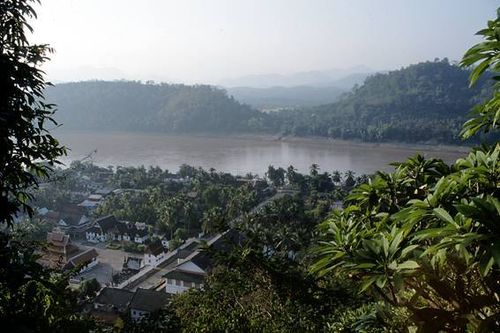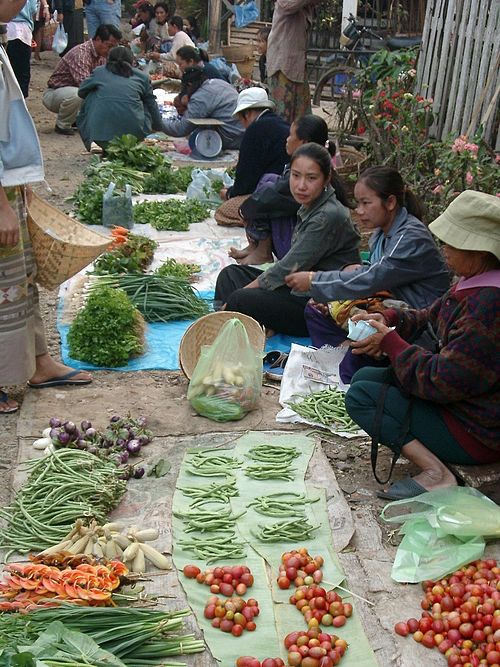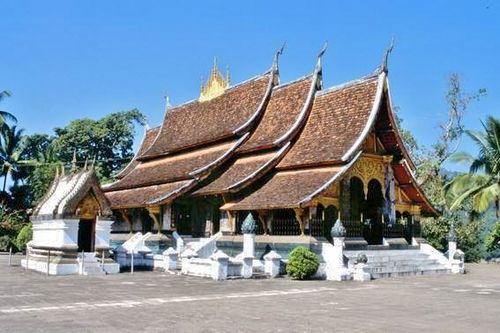Luang Prabang, or Louangphrabang (Lao: ຫຼວງພຣະບາງ, literally: "Royal Buddha Image (in the Dispelling Fearmudra)," pronounced [lǔaŋ pʰra.bàːŋ]), is the capital city of Luang Prabang Province in north central Laos. The city is located at the confluence of the Nam Khan and Mekong Rivers about 300 km north of Vientiane. The population of the city is about 50,000.[1]
The city was formerly the capital of a kingdom of the same name. It had also been known by the ancient name ofChiang Thong.[2] Until the communist takeover in 1975, it was the royal capital and seat of government of theKingdom of Laos. The old town centre is a UNESCO World Heritage Site.
The main part of the city consists of four main roads on a peninsula between the Nam Khan and Mekong Rivers. The city is well known for its numerous Buddhist temples and monasteries. Every morning, hundreds of monks from the various monasteries walk through the streets collecting alms. One of the major landmarks in the city is a large steep hill on which sits Wat Chom Si.
Muang Sua was the old name of Luang Prabang following its conquest in 698 CE by a Tai prince, Khun Lo. Khun Lo had been awarded the town by his father, Khun Borom, who is associated with the Lao legend of the creation of the world, which the Lao share with the Shan and other peoples of the region. Khun Lo established a dynasty whose fifteen rulers reigned over an independent Muang Sua for nearly a century.[citation needed]
In the second half of the 8th century, Nan-chao intervened frequently in the affairs of the principalities of the middle Mekong Valley, resulting in the occupation of Muang Sua in 709. Nan-chao princes or administrators replaced the aristocracy of Tai overlords. Dates of the occupation are not known, but it probably ended well before the northward expansion of the Khmer empire under Indravarman I (r. 877-89) and extended as far as the territories of Sipsong Pannaon the upper Mekong.[citation needed]
In the meantime, the Khmers founded an outpost at Xay Fong near Vientiane, and Champa expanded again in southern Laos, maintaining its presence on the banks of the Mekong until 1070. Chanthaphanit, the local ruler of Xay Fong, moved north to Muang Sua and was accepted peacefully as ruler after the departure of the Nan-chao administrators. Chanthaphanit and his son had long reigns, during which the town became known by the Tai name Xieng Dong Xieng Thong.[citation needed]
The dynasty eventually became involved in the squabbles of a number of principalities. Khun Chuang, a warlike ruler who may have been a Kammu (alternate spellings include Khamu and Khmu) tribesman, extended his territory as a result of the warring of these principalities and ruled from 1128 to 1170. Khun Chuang, a single family ruled over a far-flung territory and reinstituted the Siamese administrative system of the 7th century. At some point, Theravada Buddhism was subsumed by Mahayana Buddhism.[citation needed]
Xieng Dong Xieng Thong experienced a brief period of Khmer suzerainty under Jayavarman VII from 1185 to 1191. By 1180 the Sipsong Panna had regained their independence from the Khmers, however, and in 1238 an internal uprising in the Khmer outpost of Sukhothai expelled the Khmer overlords. Xieng Dong Xieng Thong in 1353 became the capital of Lan Xang. The capital was moved in 1560 by King Setthathirath I to Vientiane, which remains the capital today.
In 1707, Lan Xang fell apart because of a dynastic struggle and Luang Prabang became the capital of the independentKingdom of Luang Phrabang. When France annexed Laos, the French recognised Luang Prabang as the royal residence of Laos. Eventually, the ruler of Luang Prabang became synonymous with the figurehead of Laos. When Laos achieved independence, the king of Luang Prabang, Sisavang Vong, became the head of state of the Kingdom of Laos.
The town was the scene of many events during and in the aftermath of World War II and it was occupied by several foreign countries during the war (Vichy France,Thailand, Imperial Japan, Free France, and Nationalist China). Initially the Vichy French controlled the city but lost it to the fascist Thai government following theFranco-Thai War of 1940-1941. On 9 March 1945, a nationalist group declared Laos once more independent, with Luang Prabang as its capital but on 7 April 1945 two battalions of Japanese troops occupied the city.[3] The Japanese attempted to force Sisavang Vong (the King of Luang Phrabang) to declare Laotian independence but on 8 April he instead simply declared an end to Laos' status as a French protectorate. The King then secretely sent Prince Kindavong to represent Laos to the Allied forces and Sisavang Vatthana as representative to the Japanese.[3]Following Japan's surrender to the Allies Free French forces were sent to reoccupy Laos and entered Luang Prabang on 25 August, at which time the King assured the French that Laos remained a French colonial protectorate.[3] In September the Chinese Nationalist forces arrived to receive the surrender of the remaining Japanese forces but also quickly set about buying up the Laotian opium crop












